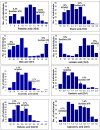Genetic mapping of QTLs controlling fatty acids provided insights into the genetic control of fatty acid synthesis pathway in peanut (Arachis hypogaea L.)
- PMID: 25849082
- PMCID: PMC4388682
- DOI: 10.1371/journal.pone.0119454
Genetic mapping of QTLs controlling fatty acids provided insights into the genetic control of fatty acid synthesis pathway in peanut (Arachis hypogaea L.)
Abstract
Peanut, a high-oil crop with about 50% oil content, is either crushed for oil or used as edible products. Fatty acid composition determines the oil quality which has high relevance to consumer health, flavor, and shelf life of commercial products. In addition to the major fatty acids, oleic acid (C18:1) and linoleic acid (C18:2) accounting for about 80% of peanut oil, the six other fatty acids namely palmitic acid (C16:0), stearic acid (C18:0), arachidic acid (C20:0), gadoleic acid (C20:1), behenic acid (C22:0), and lignoceric acid (C24:0) are accounted for the rest 20%. To determine the genetic basis and to improve further understanding on effect of FAD2 genes on these fatty acids, two recombinant inbred line (RIL) populations namely S-population (high oleic line 'SunOleic 97R' × low oleic line 'NC94022') and T-population (normal oleic line 'Tifrunner' × low oleic line 'GT-C20') were developed. Genetic maps with 206 and 378 marker loci for the S- and the T-population, respectively were used for quantitative trait locus (QTL) analysis. As a result, a total of 164 main-effect (M-QTLs) and 27 epistatic (E-QTLs) QTLs associated with the minor fatty acids were identified with 0.16% to 40.56% phenotypic variation explained (PVE). Thirty four major QTLs (>10% of PVE) mapped on five linkage groups and 28 clusters containing more than three QTLs were also identified. These results suggest that the major QTLs with large additive effects would play an important role in controlling composition of these minor fatty acids in addition to the oleic and linoleic acids in peanut oil. The interrelationship among these fatty acids should be considered while breeding for improved peanut genotypes with good oil quality and desired fatty acid composition.
Conflict of interest statement
Figures







Similar articles
-
Identification of QTLs associated with oil content and mapping FAD2 genes and their relative contribution to oil quality in peanut (Arachis hypogaea L.).BMC Genet. 2014 Dec 10;15:133. doi: 10.1186/s12863-014-0133-4. BMC Genet. 2014. PMID: 25491595 Free PMC article.
-
Genome-wide approaches delineate the additive, epistatic, and pleiotropic nature of variants controlling fatty acid composition in peanut (Arachis hypogaea L.).G3 (Bethesda). 2022 Jan 4;12(1):jkab382. doi: 10.1093/g3journal/jkab382. G3 (Bethesda). 2022. PMID: 34751378 Free PMC article.
-
Genotypic effect of ahFAD2 on fatty acid profiles in six segregating peanut (Arachis hypogaea L) populations.BMC Genet. 2013 Jul 17;14:62. doi: 10.1186/1471-2156-14-62. BMC Genet. 2013. PMID: 23866023 Free PMC article.
-
An Overview of Mapping Quantitative Trait Loci in Peanut (Arachis hypogaea L.).Genes (Basel). 2023 May 28;14(6):1176. doi: 10.3390/genes14061176. Genes (Basel). 2023. PMID: 37372356 Free PMC article. Review.
-
Omics-driven advances in the understanding of regulatory landscape of peanut seed development.Front Plant Sci. 2024 May 3;15:1393438. doi: 10.3389/fpls.2024.1393438. eCollection 2024. Front Plant Sci. 2024. PMID: 38766472 Free PMC article. Review.
Cited by
-
Characterization and Transferable Utility of Microsatellite Markers in the Wild and Cultivated Arachis Species.PLoS One. 2016 May 31;11(5):e0156633. doi: 10.1371/journal.pone.0156633. eCollection 2016. PLoS One. 2016. PMID: 27243460 Free PMC article.
-
Mapping Quantitative Trait Loci of Resistance to Tomato Spotted Wilt Virus and Leaf Spots in a Recombinant Inbred Line Population of Peanut (Arachis hypogaea L.) from SunOleic 97R and NC94022.PLoS One. 2016 Jul 18;11(7):e0158452. doi: 10.1371/journal.pone.0158452. eCollection 2016. PLoS One. 2016. PMID: 27427980 Free PMC article.
-
Genetic mapping of yield traits using RIL population derived from Fuchuan Dahuasheng and ICG6375 of peanut (Arachis hypogaea L.).Mol Breed. 2017;37(2):17. doi: 10.1007/s11032-016-0587-3. Epub 2017 Jan 30. Mol Breed. 2017. PMID: 28216998 Free PMC article.
-
Quantitative Trait Locus Analysis of Late Leaf Spot Resistance and Plant-Type-Related Traits in Cultivated Peanut (Arachis hypogaea L.) under Multi-Environments.PLoS One. 2016 Nov 21;11(11):e0166873. doi: 10.1371/journal.pone.0166873. eCollection 2016. PLoS One. 2016. PMID: 27870916 Free PMC article.
-
High-resolution genetic and physical mapping reveals a peanut spotted wilt disease resistance locus, PSWDR-1, to Tomato spotted wilt virus (TSWV), within a recombination cold-spot on chromosome A01.BMC Genomics. 2025 Mar 6;26(1):224. doi: 10.1186/s12864-025-11366-7. BMC Genomics. 2025. PMID: 40050730 Free PMC article.
References
-
- Dean LL, Hendrix KW, Holbrook CC, Sanders TH. Content of some nutrient in the core of the core of peanut germplasm collection. Peanut Sci. 2009;36: 104–120.
-
- Rizzo WB, Watkins PA, Phillips MW, Cranin D, Campbell B, Avigan J. Adrenoleukodystrophy: Oleic acid lowers fibroblast saturated C22-26 fatty acids. Neurology 1986;36: 357–61. - PubMed
-
- Vassiliou EK, Gonzalez A, Garcia C, Tadros JH, Chakraborty G, Toney JH. Oleic acid and peanut oil high in oleic acid reverse the inhibitory effect of insulin production of the inflammatory cytokine TNF-a both in vitro and in vivo system. Lipids Health Dis. 2009;8: 25 10.1186/1476-511X-8-25 - DOI - PMC - PubMed
-
- Wang ML, Chen CY, Davis J, Guo B, Stalker HT, Pittman RN. Assessment of oil content and fatty acid composition variability in different peanut subspecies and botanical varieties. Plant Genet Resour C. 2009;8: 71–73.
Publication types
MeSH terms
Substances
LinkOut - more resources
Full Text Sources
Other Literature Sources
Research Materials
Miscellaneous

